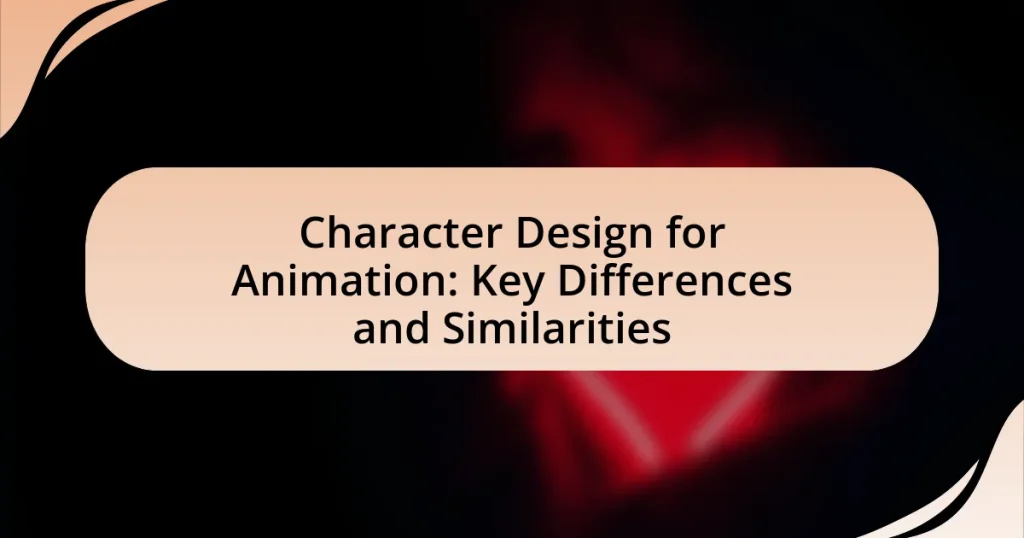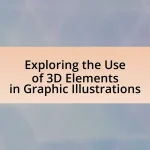Character design for animation is the process of creating the visual appearance and personality of characters for animated media, encompassing their physical traits, clothing, color schemes, and expressions. This article explores how character design influences storytelling, audience engagement, and brand identity, highlighting key elements such as shape, color, silhouette, and personality traits. It also addresses the unique challenges animators face, the differences between character design in animation and other mediums, and best practices for optimizing character design. Additionally, the article discusses common pitfalls, strategies for ensuring originality, and essential tools for effective character design in animation.
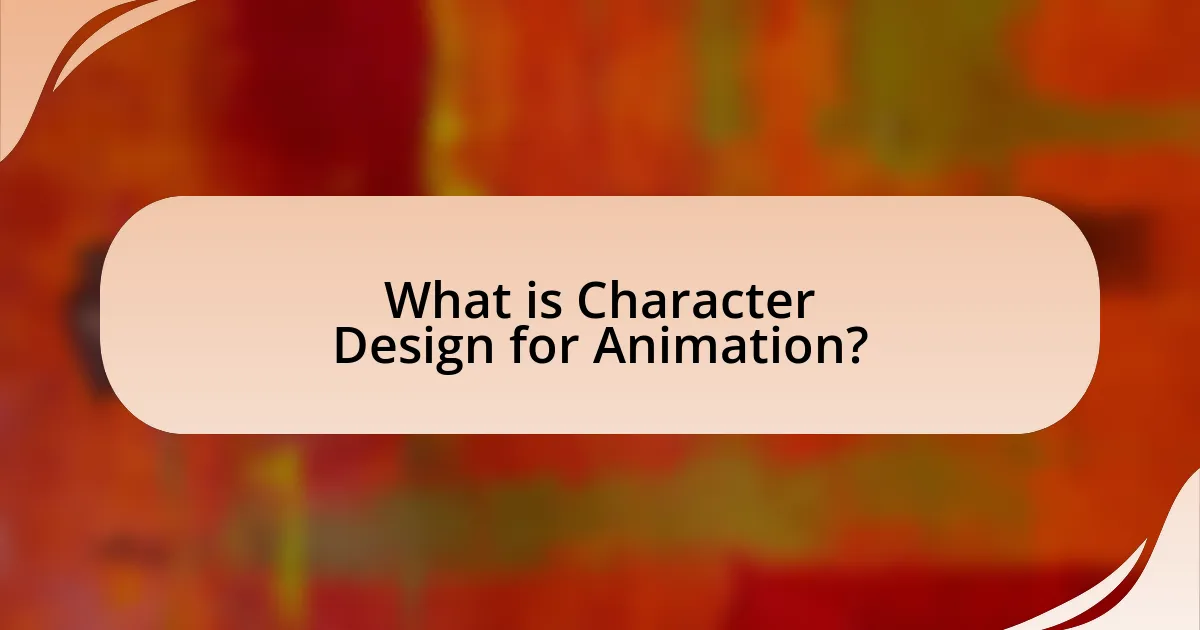
What is Character Design for Animation?
Character design for animation is the process of creating the visual appearance and personality of characters intended for animated media. This involves defining their physical traits, clothing, color schemes, and expressions to convey emotions and traits effectively. Character design is crucial as it influences how audiences perceive and connect with the characters, impacting storytelling and viewer engagement. For instance, iconic animated characters like Mickey Mouse and Bugs Bunny showcase distinct designs that reflect their personalities and roles within their narratives, demonstrating the importance of effective character design in animation.
How does character design influence animated storytelling?
Character design significantly influences animated storytelling by shaping audience perception and emotional engagement with characters. Well-crafted character designs convey personality traits, motivations, and relationships, which are essential for narrative development. For instance, a character with exaggerated features may evoke humor or villainy, while a more realistic design can foster empathy. Research indicates that character design impacts viewer attachment; a study published in the Journal of Visual Culture found that distinct visual traits enhance memorability and emotional resonance, thereby driving the story forward. Thus, effective character design is crucial for creating compelling narratives in animation.
What are the key elements of character design in animation?
The key elements of character design in animation include shape, color, silhouette, and personality traits. Shape influences how a character is perceived; for example, round shapes often convey friendliness, while sharp shapes can suggest danger. Color plays a crucial role in evoking emotions and setting the tone; bright colors may indicate a cheerful character, while darker hues can imply seriousness or villainy. Silhouette is essential for instant recognition; a unique outline helps viewers identify characters quickly. Lastly, personality traits are reflected in design choices, such as facial expressions and clothing, which communicate the character’s role and emotional state. These elements work together to create memorable and relatable characters in animated works.
How do character designs reflect personality and emotion?
Character designs reflect personality and emotion through visual elements such as shape, color, and detail. For instance, rounded shapes often convey friendliness and approachability, while sharp angles can suggest aggression or tension. Color choices also play a significant role; warm colors like red and orange can evoke excitement or anger, while cool colors like blue and green typically represent calmness or sadness. Additionally, the level of detail in a character’s design can indicate their complexity; a highly detailed character may suggest depth and nuance, whereas a simpler design might imply a more straightforward personality. These design principles are supported by studies in visual perception, which show that viewers instinctively interpret shapes and colors in relation to emotional states.
What are the primary goals of character design in animation?
The primary goals of character design in animation are to create visually appealing and memorable characters that effectively convey personality and emotion. This involves establishing a unique visual style that aligns with the narrative and themes of the animation, ensuring that characters are easily recognizable and relatable to the audience. Additionally, character design aims to facilitate animation by considering the character’s movement and expressions, which enhances storytelling and audience engagement. For instance, characters designed with exaggerated features can express emotions more clearly, making them more impactful in conveying the story’s message.
How does character design contribute to audience engagement?
Character design significantly contributes to audience engagement by creating relatable and visually appealing characters that resonate with viewers. Engaging character design captures attention through unique visual traits, emotional expressions, and distinct personalities, which help audiences form connections with the characters. Research indicates that well-designed characters can enhance emotional investment; for instance, a study published in the Journal of Visual Culture found that characters with clear visual identities and relatable traits lead to increased viewer empathy and attachment. This emotional connection fosters a deeper engagement with the narrative, encouraging audiences to invest time and interest in the story being told.
What role does character design play in brand identity?
Character design plays a crucial role in brand identity by creating a visual representation that embodies the brand’s values and personality. This visual representation helps consumers recognize and connect with the brand, fostering loyalty and emotional engagement. For instance, brands like Disney utilize character design to establish a distinct identity that resonates with audiences, making their characters iconic and instantly recognizable. Research indicates that 70% of consumers are more likely to remember a brand when it is associated with a character, highlighting the effectiveness of character design in enhancing brand recall and differentiation in a competitive market.
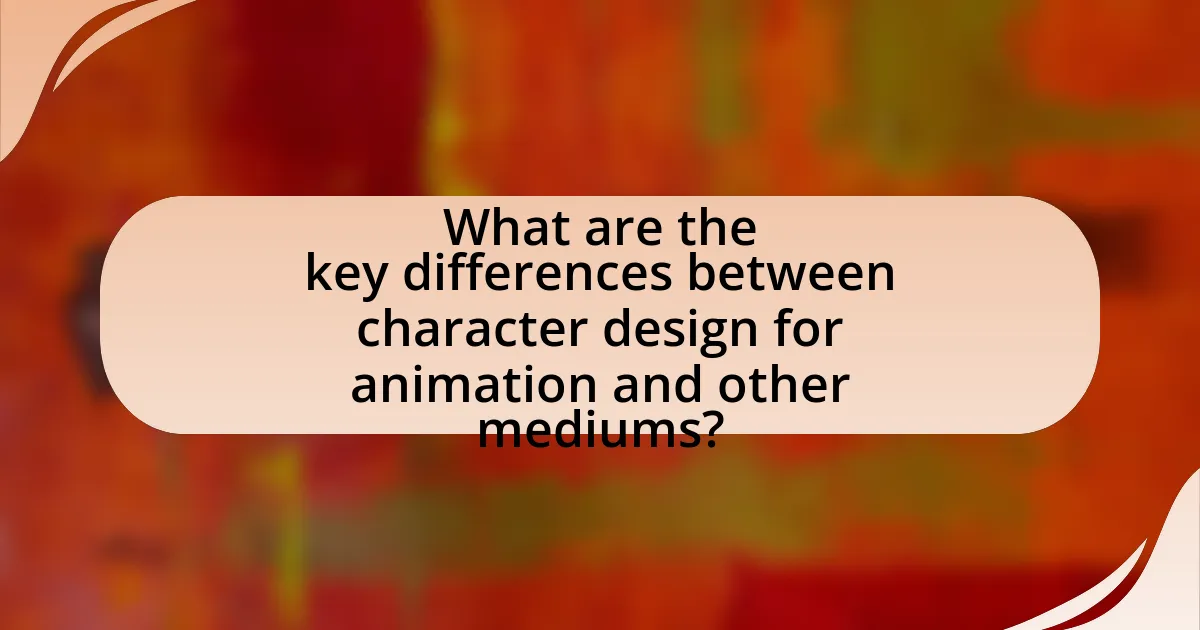
What are the key differences between character design for animation and other mediums?
Character design for animation differs significantly from other mediums primarily in its emphasis on movement and expressiveness. In animation, characters must be designed with a focus on how they will move and convey emotions through motion, requiring a more dynamic approach to proportions, shapes, and facial expressions. For instance, animated characters often utilize exaggerated features to enhance expressiveness, which is less common in static mediums like illustration or sculpture, where the design may prioritize realism or detail over movement. Additionally, animation requires consideration of the character’s design across various frames and angles, ensuring consistency in appearance during motion, while other mediums may not necessitate such extensive planning for movement.
How does the animation process affect character design choices?
The animation process significantly influences character design choices by dictating the visual style, movement fluidity, and emotional expression of characters. For instance, animators often prioritize designs that facilitate exaggerated movements and clear silhouettes, which enhance the character’s expressiveness and readability on screen. This is evident in 2D animation, where characters are designed with bold outlines and simplified features to ensure clarity during dynamic actions. Additionally, the animation technique, whether traditional hand-drawn or computer-generated, impacts the level of detail and complexity in character designs, as seen in Pixar’s characters, which balance realism with stylization to support their storytelling. Thus, the animation process shapes character design by aligning visual elements with the intended animation style and narrative requirements.
What unique challenges do animators face in character design?
Animators face unique challenges in character design, primarily related to balancing artistic vision with technical constraints. They must create characters that are visually appealing and expressive while ensuring that these designs can be effectively animated within the limitations of the chosen medium, such as frame rates and software capabilities. Additionally, animators must consider the character’s personality and story arc, which requires a deep understanding of character development principles. For instance, a character’s design must convey emotions and traits that align with their narrative role, which can complicate the design process. These challenges are compounded by the need for consistency across various poses and movements, necessitating a thorough understanding of anatomy and motion dynamics.
How do movement and expression differ in animated character design?
Movement in animated character design refers to the physical actions and dynamics of a character, while expression pertains to the emotional and psychological portrayal through facial features and body language. Movement is characterized by principles such as timing, spacing, and weight, which dictate how a character interacts with their environment and conveys action. For example, a character running will exhibit different body mechanics compared to one walking, showcasing speed and urgency versus calmness.
In contrast, expression focuses on the subtleties of a character’s face and posture to communicate feelings like happiness, anger, or sadness. Techniques such as exaggeration and squash-and-stretch are often employed to enhance emotional impact. For instance, a character’s wide eyes and raised eyebrows can indicate surprise, while a slumped posture may suggest defeat.
The distinction lies in movement being about physicality and action, while expression conveys emotional depth and personality, both essential for creating relatable and engaging animated characters.
What are the similarities in character design across different mediums?
Character design across different mediums shares several key similarities, primarily in the use of visual elements, thematic consistency, and character archetypes. Visual elements such as color palettes, shapes, and proportions are often consistent to convey personality traits and emotions, regardless of whether the medium is animation, video games, or comics. Thematic consistency ensures that characters resonate with audiences by embodying universal themes like heroism or conflict, which are prevalent across various forms of storytelling. Additionally, character archetypes, such as the mentor or the trickster, appear consistently across mediums, allowing for recognizable and relatable characters that enhance audience engagement. These similarities facilitate a cohesive understanding of characters, making them effective across diverse platforms.
How do fundamental design principles apply to both animation and static art?
Fundamental design principles such as balance, contrast, emphasis, movement, pattern, rhythm, and unity apply to both animation and static art by guiding the visual composition and enhancing viewer engagement. In static art, balance ensures that elements are distributed evenly, creating a harmonious look, while in animation, balance helps maintain visual stability across frames, preventing disorientation. Contrast in static art highlights differences between elements, drawing attention to focal points, whereas in animation, it can be used to create dynamic scenes that capture movement and change. Emphasis directs the viewer’s focus in both mediums, with static art using size or color, and animation employing timing and motion to highlight key actions. Movement is inherent in animation but can also be suggested in static art through lines and shapes, creating a sense of action. Pattern and rhythm contribute to the overall aesthetic in both forms, establishing a visual flow that guides the viewer’s eye. Lastly, unity ensures that all elements work together cohesively, whether in a single frame of static art or across multiple frames in animation, creating a seamless narrative experience.
What common techniques are used in character design across various platforms?
Common techniques used in character design across various platforms include silhouette creation, color theory application, and expression design. Silhouette creation ensures that characters are easily recognizable and distinct, which is crucial for visual storytelling in animation and gaming. Color theory application involves selecting color palettes that convey personality traits and emotional states, enhancing audience connection. Expression design focuses on developing a range of facial and body expressions to communicate character emotions effectively, which is essential for engaging narratives. These techniques are foundational in character design, as they help create memorable and relatable characters across different media.
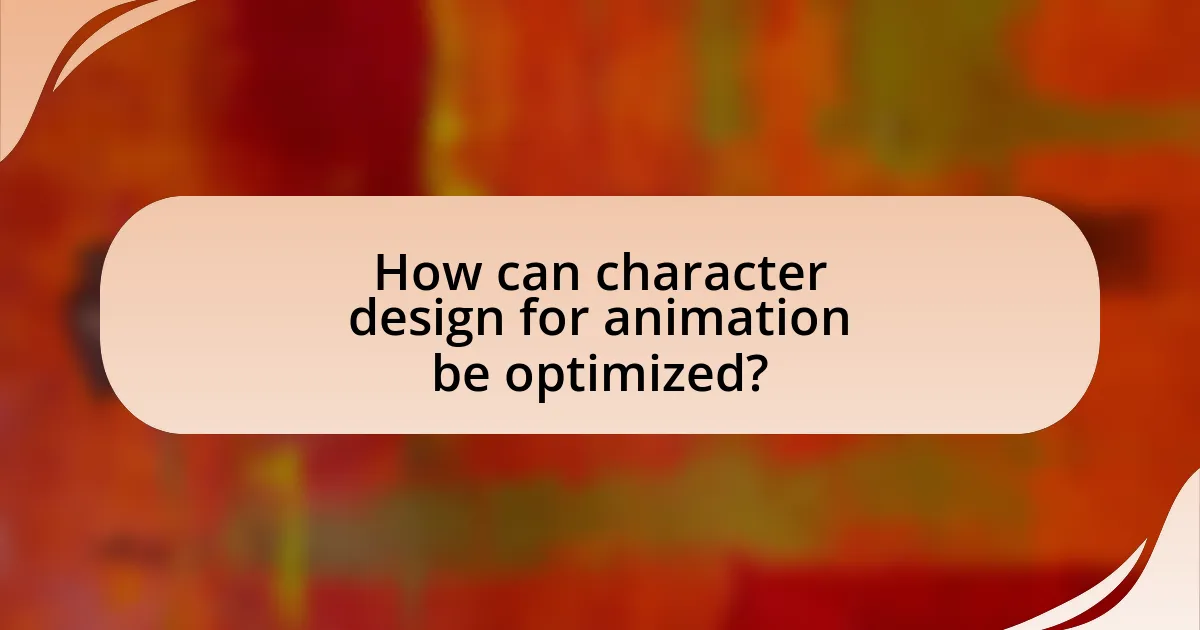
How can character design for animation be optimized?
Character design for animation can be optimized by ensuring clarity, simplicity, and adaptability in the character’s visual traits. Clear silhouettes and distinct features enhance recognition and memorability, while simplicity allows for easier animation and reduces production time. Adaptability ensures that characters can be easily modified for various scenes and emotions, which is crucial for maintaining consistency across different animations. Research indicates that characters with strong, recognizable designs lead to better audience engagement and retention, as seen in successful animated series like “The Simpsons” and “Toy Story,” where character designs are both iconic and versatile.
What best practices should be followed in character design for animation?
Best practices in character design for animation include creating distinct silhouettes, ensuring expressiveness, and maintaining consistency in style. Distinct silhouettes allow characters to be easily recognizable and memorable, which is crucial for audience engagement. Expressiveness is vital as it conveys emotions and personality, enhancing storytelling; for instance, characters with exaggerated features can communicate feelings more effectively. Consistency in style ensures that characters remain visually coherent throughout the animation, which is essential for maintaining viewer immersion. These practices are supported by industry standards, such as those outlined in “The Animator’s Survival Kit” by Richard Williams, which emphasizes the importance of clarity and appeal in character design.
How can feedback and iteration improve character design outcomes?
Feedback and iteration significantly enhance character design outcomes by allowing designers to refine their concepts based on external input and repeated assessments. This process enables designers to identify strengths and weaknesses in their character designs, leading to more effective visual storytelling. For instance, incorporating feedback from peers or target audiences can reveal insights that the original designer may overlook, such as cultural relevance or emotional impact. Iteration allows for multiple revisions, which can improve the design’s functionality and appeal, as seen in successful animated films where character designs evolve through testing and critique, ultimately resulting in more relatable and memorable characters.
What tools and software are essential for effective character design?
Essential tools and software for effective character design include Adobe Photoshop, Adobe Illustrator, and Blender. Adobe Photoshop is widely used for creating detailed character illustrations and concept art due to its robust painting and editing capabilities. Adobe Illustrator is favored for vector-based designs, allowing for scalable character graphics. Blender is a powerful 3D modeling software that enables character rigging and animation, making it essential for bringing characters to life in a three-dimensional space. These tools are industry standards, utilized by professional character designers to create visually compelling and functional designs.
What are the common pitfalls in character design for animation?
Common pitfalls in character design for animation include lack of clarity in character silhouette, inconsistent design elements, and neglecting the character’s personality traits. A clear silhouette is crucial for recognition and readability; characters with overly complex shapes can confuse viewers. Inconsistent design elements, such as varying styles or proportions, can disrupt the visual coherence of the animation, making it difficult for audiences to connect with the character. Additionally, failing to incorporate personality traits into the design can result in characters that feel flat or unrelatable, diminishing audience engagement. These pitfalls are well-documented in animation studies, emphasizing the importance of cohesive and expressive character design for effective storytelling.
How can designers avoid clichés in character design?
Designers can avoid clichés in character design by conducting thorough research on diverse cultures, personalities, and experiences to create unique and relatable characters. This approach encourages originality and depth, steering clear of overused tropes. For instance, analyzing character archetypes and their subversions can lead to innovative designs that resonate with audiences. Additionally, engaging in brainstorming sessions with diverse teams can provide fresh perspectives, further reducing reliance on common clichés.
What strategies can be employed to ensure originality in character design?
To ensure originality in character design, artists can employ strategies such as extensive research, unique cultural influences, and iterative sketching. Researching various art styles, historical figures, and diverse cultures can inspire fresh ideas and prevent clichés. Incorporating unique cultural elements allows for the creation of characters that resonate with authenticity and depth. Iterative sketching, where multiple variations of a character are developed, fosters innovation and helps identify distinctive features that set the character apart. These strategies are supported by the fact that original designs often emerge from a blend of influences and continuous refinement, as seen in successful animated films that prioritize character uniqueness.
What practical tips can enhance character design for animation?
To enhance character design for animation, focus on creating distinct silhouettes, which allows characters to be easily recognizable and memorable. Distinct silhouettes help convey personality and traits without the need for detailed features, as seen in successful animated films like “The Incredibles,” where each character has a unique outline that reflects their role and personality. Additionally, employing a color palette that aligns with the character’s traits can evoke specific emotions and associations; for instance, warm colors often represent friendliness, while cool colors can suggest calmness or aloofness. Furthermore, incorporating exaggerated features and expressions can enhance the character’s appeal and relatability, as demonstrated in the animation style of Pixar, where characters often have oversized eyes and expressive faces to convey emotions effectively. Lastly, ensuring that the character’s design is adaptable for various poses and movements is crucial, as it allows for fluid animation and maintains the character’s integrity across different scenes.
